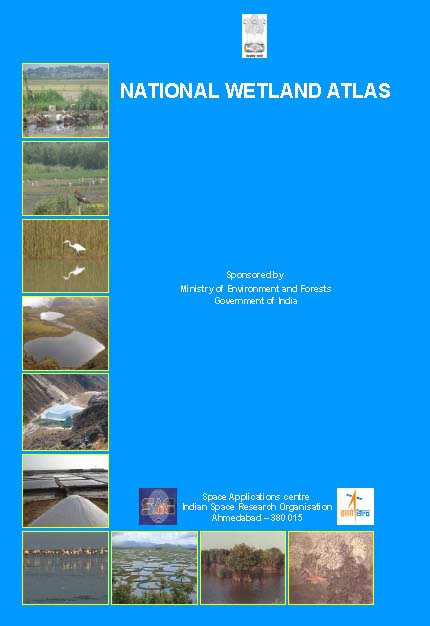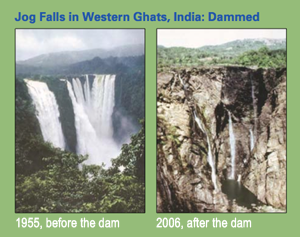Ecology and Environment
Presentations from the two-day workshop on success stories under watershed programmes by DoLR at New Delhi (2011)
Posted on 18 Jun, 2011 06:50 PMThe workshop was structured in two sections. Research papers were presented from research institutes such as Central Research Institute for Dryland Agriculture (CRIDA), Central Soil & Water Conservation Research and Training Institute (CSWRTI), Deutsche Gesellschaft für Internationale Zusammenarbeit (GIZ) GmbH, International Crops Research Institute for the Semi-Arid Tropics (ICRISAT), National Research Centre for Agroforestry (NRCAF), National Institute for Rural Development (NIRD) and National Bank for Agriculture and Rural Development (NABARD). This was followed by presentation of success stories by various States.
"Battles over land" - Land as commodity and land for livelihoods - Special issue from Infochange
Posted on 18 Jun, 2011 12:48 AMWhat are the laws governing acquisition? What is the social impact of a development-at-all-costs policy? Can those who owned and lived off the land have a stake in its development?
National Wetland Atlas – An updated database of wetlands in India by the Ministry of Environment and Forests (2011)
Posted on 17 Jun, 2011 02:44 PM This book by Space Applications Centre (SAC), Indian Space Research Organisation (ISRO) is an outcome of the project on National Wetland Inventory and Assessment (NWIA) . Increasing concern about how our wetlands are being influenced had led to formulation of the project entitled to create an updated database of the wetlands of India.
This book by Space Applications Centre (SAC), Indian Space Research Organisation (ISRO) is an outcome of the project on National Wetland Inventory and Assessment (NWIA) . Increasing concern about how our wetlands are being influenced had led to formulation of the project entitled to create an updated database of the wetlands of India.
Wetlands defined as areas of land that are either temporarily or permanently covered by water exhibit enormous diversity according to their genesis, geographical location, water regime and chemistry. They are one of the most productive ecosystems and play crucial role in hydrological cycle. Utility-wise, wetlands directly and indirectly support millions of people in providing services such as storm and flood control, clean water supply, food, fiber and raw materials, scenic beauty, educational and recreational benefits. Thus, their identification and protection becomes very important.
Workshop on life cycle assessment, CII-Godrej GBC, 8th July, 2011, Hyderabad
Posted on 17 Jun, 2011 12:41 PMOrganizer: Confederation of Indian Industry CII – Sohrabji Godrej Green Business Centre
Venue: CII – Sohrabji Godrej GBC, Survey No. 64, Kothagunda Post, Near Hitech City, R R District, Hyderabad
Topics:
- Introduction to life cycle assessment
- Demonstration of LCA software tool
Women at the center of climate friendly approaches to agriculture and water use - A report by the Institute for Agriculture and Trade Policy
Posted on 17 Jun, 2011 10:45 AM The Institute for Agriculture and Trade Policy draws on the experiences of the Tamilnadu Women’s Collective (WC), a state-level federation of women’s groups from 1,500 villages, in the context where communities all around the world are struggling to find ways to cope with changes affecting food and water security because of the phenomenon of climate change.
The report argues that many a times, new food and water security policies at the national and international level tend to be narrow, look at each of these issues in isolation and undermine food and water security strategies adopted by individuals and households from marginal groups. Adaptation strategies to address food security focus almost exclusively on increasing agricultural production, while ignoring health and cultural aspects of the food being produced, and the role of agriculture as a means for rural viability.
MoEF signs three agreements with World Bank for cleaning Ganga and conservation of biodiversity in June 2011
Posted on 16 Jun, 2011 04:55 PMThe River cleaning project is to the tune of US $ 1 billion (approximately Rs 4,600 crore) loan and credit that will form part of the Bank’s long-term support for cleaning the Ganga River. Two Biodiversity Conservation agreements are for a credit of US$15.6 million and US$8.14 million grant.
On this occasion, Sh Jairam Ramesh , Minister of State for Environment and Forest Minister said, “Two protected areas, one each in Uttarakhand and Gujarat, will put in place a complete new model of managing the protected areas while safeguarding the livelihoods of local communities. So far local community was looked as enemies of protected areas, but this has to be changed. We have to make local communities full partners in the protection and regeneration of these protected areas. These new models will be applied in other areas of the country.” Giving details of cleaning operations of last few years, the Minister said, “The objective of Ganga project is ‘by 2020 no municipal sewage and industrial effluent will be let into the river Ganga without treatment’. With the help from the World bank, we are taking a big step forward in achieving the Mission Clean Ganga”.
The economic impact of forest hydrological services on local communities - A case study from the western ghats of India by South Asian Network for Development and Environmental Economics (SANDEE)
Posted on 16 Jun, 2011 03:38 PMThe paper informs that the conventional wisdom that ‘more forest is always better’ has dominated policy making in the management of forested watersheds. In the context of the supposed hydrological regulation service provided by forest ecosystems, however, hydrologists have debated this assumption for more than two decades.
Of soils, subsidies and survival - A report on living soils by Greenpeace India
Posted on 15 Jun, 2011 09:54 AMSoil is one of the basic natural resources that supports life on Earth. It is an ecosystem, which is a home to several living organisms, which make the soil alive and give it a good structure and texture.
A living soil ecosystem nurtures and nourishes plants by providing a healthy medium to take roots through a steady supply of nutrients. Use of chemical fertilisers disturbs the natural soil ecosystem and its indiscriminate use has resulted in the degradation of soil. A total neglect of ecological/organic fertilisation by policy makers, extension officers and farmers during the peak Green Revolution period has also added to the soil health crisis.
This report pools together scientific literature as well as farmers’ views on this issues as many a times, while studying issues related to soil health or while making policies related to it, the farmer, who is the most important stakeholder, is seldom consulted. The report has made an effort to rectify this grave inadequacy by including the farmer's perspectives in the academic processes like the social surveys, public hearings and workshops and in this final report. Every section of the report has a component from the existing scientific literature available and another one on the farmers’ opinion on the same area.
Changing with the seasons: How Himalayan communities cope with climate change - A report by Peoples’ Science Institute
Posted on 14 Jun, 2011 10:51 PMMountain areas and communities are susceptible to climate change. This work also yielded evidence of the coping strategies developed by the communities to deal with an unprecedented and only partially understood threat. This paper describes these strategies and attempts to assess the vulnerability of the communities in each valley.
Taking action in India on downstream impact of dams - Report of the workshop held by International Rivers and Save Western Ghats Movement at Jog Falls, Karnataka in May 2011
Posted on 14 Jun, 2011 05:17 PM Jog falls in Western Ghats
Jog falls in Western Ghats
These dams have had a profound negative impact on communities and ecology upstream and downstream. While promised benefits of these dams (irrigation, hydro-power or flood control) have been overstated, numerous interrelated and complex negative impacts have simply not been studied or documented. Nonetheless, communities and ecosystems continue paying huge prices of these impacts.




